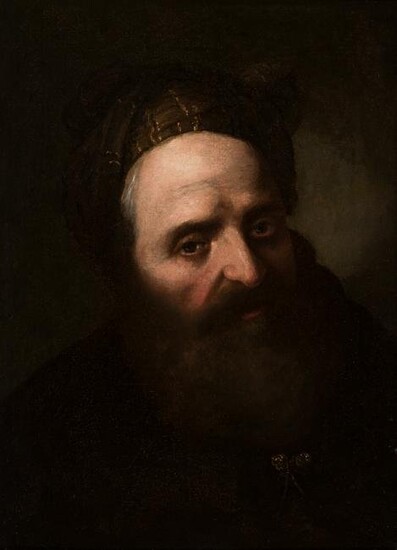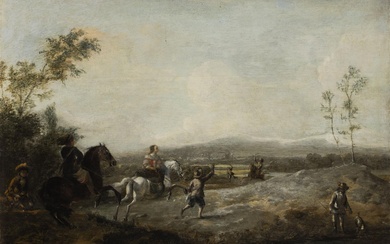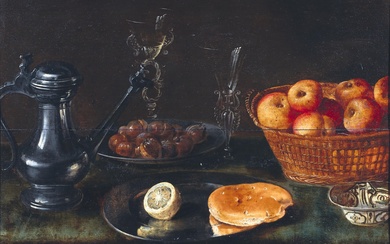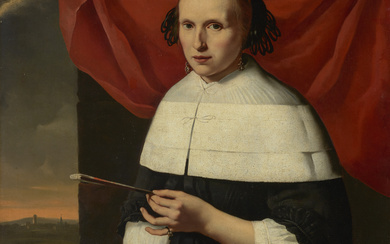Dutch school; XVII century. "Portrait" Oil on canvas. Reengineered. It presents multiple repaints
Dutch school; 17th century.
"Portrait".
Oil on canvas. Re-coloured.
It presents multiple repainting and has a frame of a later period.
Measurements: 52 x 38 cm; 77 x 62 cm (frame).
We see in this work a male portrait that presents us a gentleman of mature age, with a thick dark beard, soberly dressed in the fashion of the time, wearing a single golden detail as a barrette, which is hardly noticeable due to the darkness of the portrait. The luminosity of the face is emphasised by the flesh tones and a spotlight directed towards the face. The artist has particularly emphasised the somewhat lost and self-absorbed gaze, which speaks to us of the character's psychology, partly breaking with the formal distance typical of Baroque portraiture. The composition is sober, typical of Dutch portraiture of the time: the sitter is depicted with a long bust, turned three-quarters of the way round with his head slightly turned towards the front, in the foreground, against a neutral, dark background, although somewhat brighter around the sitter's head. His face is modelled through a contrasting light of Tenebrist heritage.
Portraiture, both individual and group, and even character portraiture, embodies the relationship between the individual and society, and therefore the state. This genre accounts for a full third of all Dutch Baroque production, and its main innovator in Holland was Frans Hals, who, thanks to the power with which he marked the character of his models, penetrating their personality to the point of giving them vitality and spontaneous truth, was able to free himself from the prevailing late Mannerism, giving rise to a new conception of portraiture. Faced with the exuberant and elegant Mannerist portraiture, of virtuoso and elaborate execution, a general reaction was triggered at the beginning of the 17th century, based on compositional austerity and operational sobriety. Thus, in contrast to the previous century's desire for virtuosity, Dutch Baroque portraitists revived the earlier models in a more sober and solid manner, focusing on the characterisation of the sitters, the elegance of the poses and the delicate capturing of the qualities of the various objects.
View it on
Estimate
Time, Location
Auction House
Dutch school; 17th century.
"Portrait".
Oil on canvas. Re-coloured.
It presents multiple repainting and has a frame of a later period.
Measurements: 52 x 38 cm; 77 x 62 cm (frame).
We see in this work a male portrait that presents us a gentleman of mature age, with a thick dark beard, soberly dressed in the fashion of the time, wearing a single golden detail as a barrette, which is hardly noticeable due to the darkness of the portrait. The luminosity of the face is emphasised by the flesh tones and a spotlight directed towards the face. The artist has particularly emphasised the somewhat lost and self-absorbed gaze, which speaks to us of the character's psychology, partly breaking with the formal distance typical of Baroque portraiture. The composition is sober, typical of Dutch portraiture of the time: the sitter is depicted with a long bust, turned three-quarters of the way round with his head slightly turned towards the front, in the foreground, against a neutral, dark background, although somewhat brighter around the sitter's head. His face is modelled through a contrasting light of Tenebrist heritage.
Portraiture, both individual and group, and even character portraiture, embodies the relationship between the individual and society, and therefore the state. This genre accounts for a full third of all Dutch Baroque production, and its main innovator in Holland was Frans Hals, who, thanks to the power with which he marked the character of his models, penetrating their personality to the point of giving them vitality and spontaneous truth, was able to free himself from the prevailing late Mannerism, giving rise to a new conception of portraiture. Faced with the exuberant and elegant Mannerist portraiture, of virtuoso and elaborate execution, a general reaction was triggered at the beginning of the 17th century, based on compositional austerity and operational sobriety. Thus, in contrast to the previous century's desire for virtuosity, Dutch Baroque portraitists revived the earlier models in a more sober and solid manner, focusing on the characterisation of the sitters, the elegance of the poses and the delicate capturing of the qualities of the various objects.







